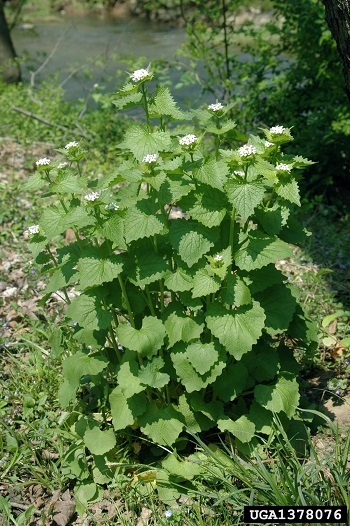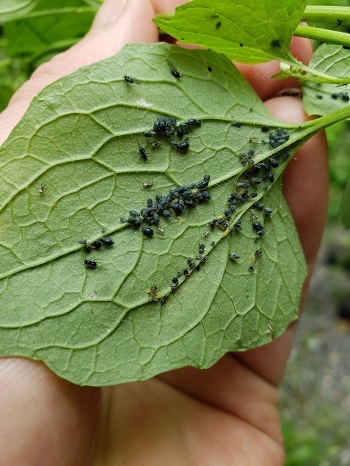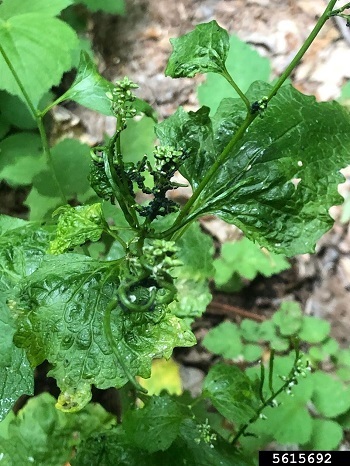|
March 28, 2023
Contact: Joanne Foreman, 517-243-6450 or Katie Grzesiak, 231-492-7811
New aphid could take a bite out of garlic mustard: Is it working in Michigan?
Ohio biologist seeks help documenting its establishment
Along with trilliums and trout lilies, invasive garlic mustard has become another harbinger of spring in Michigan. Right now, the pesky plant is popping up along roadsides, trails and streams, carpeting forest floors and taking hold wherever it finds open ground or disturbed soils.
First-year plants, called basal rosettes, appear as serrated, round-leaved ground cover. Long, 1- to 4-foot stems bolt from second-year plants, sporting spring clusters of tiny, white, four-petaled flowers. Crushing the leaves or stem releases the plant’s telltale garlic odor.
Survival skills

Anyone who has experience managing a garlic mustard infestation is familiar with its persistence. Hand-pulling is the most common method of control and can yield bags and bags of plant material each spring. Plants can produce hundreds of tiny seeds that spread easily to start new patches.
Garlic mustard exhibits habits common to successful invaders. It gets an early start and covers a lot of ground, ensuring it will outcompete most native plants. It’s not picky about where it puts down roots. Sun, shade, moist or dry soils – it seems anywhere is suitable for this widespread plant. Garlic mustard has one more tool in its toolbelt – allelopathy – the ability to release chemicals that can limit or prevent the growth of other plants.
|
If you can't beat 'em, eat 'em?
Native to Europe, garlic mustard is an herb with both food and medicinal uses. It was brought to the United States intentionally by settlers in the 1800s. Without its native predators, garlic mustard thrives here relatively unchecked.
The plant is a favorite of “invasivores” – a term combining “invasive species” and “devour” to characterize one who eats invasive species, according to Invasivore.org. Its garlic flavor can season soups, meats and sauces, and its leaves and stems can be added to salads or used as a garnish.
Though the goal of using, instead of wasting, edible invasive species is worthy, unfortunately, it hasn’t made a dent in the invasive plant’s population, leaving invasive species managers looking for new solutions.
Enter the hungry aphid

What if there was a creature out there that just loved to eat garlic mustard?
Thanks to Rebecah Troutman, a natural areas biologist at Holden Forests and Gardens in Ohio, we now know there is.
While pulling garlic mustard at Holden in 2021, Troutman noticed a plant covered with tiny insects.
“I did some Googling and made a preliminary identification of the garlic mustard aphid, Lipaphis alliarae,” said Troutman. “I then sent a sample to Doris Lagos-Kutz, research associate at the U.S. Department of Agriculture, who confirmed it was the first official sighting of the European aphid in the U.S.”
|

The garlic mustard aphid is a small, dark gray to green insect sometimes called the “grenade” aphid due to the pattern of raised blotches on its back. It sucks sap from garlic mustard plants, causing puckered, yellowed or wilting leaves and twisted seed pods.
Troutman communicated her find to the Midwest Invasive Plant Network, where coordinator Michelle Beloskur is helping spread the word in hopes of finding more places where the garlic mustard aphid is already at work.
“Since 2021, we’ve identified isolated populations in Connecticut, Massachusetts, Michigan, Minnesota, Ohio and Wisconsin,” said Beloskur. “We’re seeing impacts like shorter plants, fewer and twisted seed pods, and less overall biomass at these sites. It appears that even a small number of aphids can affect plant growth.”
|
Help is needed
This spring, Beloskur and Troutman hope to identify more garlic mustard aphid locations to better understand the aphid’s range and impact, and they’re asking for help.
If you see the aphid or notice its signs on garlic mustard plants:

- Report the sighting at EDDMapS.org/Report or on the downloadable EDDMapSApp.
- Users need to sign in and create a password.
- Include close-up photos of plant damage and/or the aphids.
- Interested in sending a sample? Email Rebecah Troutman, RTroutman@HoldenFG, for instructions on packaging and mailing.
- Negative sightings, where garlic mustard is present but the aphid is not, also can be reported through EDDMapS.
More information on reporting garlic mustard aphids is available in the online MIPN brochure Be on the lookout: Help us find garlic mustard aphids.
|
A reminder about disposal
When removing garlic mustard, be sure to double-bag all plant material and place bags in sunlight for a few days to allow plants to decompose before disposal. Composting is not recommended, as seeds can remain viable. More information is available in the Michigan Citizens’ Guide to Invasive Plant Disposal.
Michigan's Invasive Species Program is cooperatively implemented by the Michigan departments of Agriculture and Rural Development; Environment, Great Lakes, and Energy; and Natural Resources.
Note to editors: Accompanying photos are available below for download. Caption information follows.
Garlic mustard rosettes: First-year garlic mustard plants grow as rosettes with round to heart-shaped leaves. Photo courtesy of Chris Evans, University of Illinois, Bugwood.org.
Garlic mustard plants: A small patch of mature garlic mustard, showing its serrated, heart-shaped leaves and tiny, white, four-petaled flowers. Photo courtesy of Chris Evans, University of Illinois, Bugwood.org.
Aphids on leaf: The underside of a garlic mustard leaf infested with garlic mustard aphids. Photo courtesy of Rebecah Troutman, Holden Forests and Gardens.
Garlic mustard aphids: A magnified image of garlic mustard aphids showing their grenade-like coloring and markings. Photo courtesy of Rebecah Troutman, Holden Forests and Gardens.
Garlic mustard aphid damage: A garlic mustard plant shows twisted seed pods and puckered leaves from aphid damage. Photo courtesy of Rebecah Troutman, Holden Forests and Gardens.
|